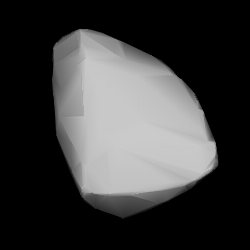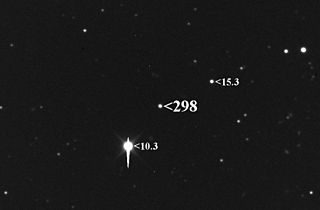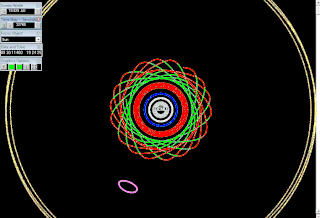Related Research Articles

3325 TARDIS is a dark Alauda asteroid from the outer region of the asteroid belt, approximately 29 kilometers in diameter. It was discovered on 3 May 1984, by American astronomer Brian Skiff at Lowell's Anderson Mesa Station, Arizona, in the United States. The asteroid was named TARDIS, after the fictional time machine and spacecraft from the science fiction television series Doctor Who.
2934 Aristophanes, provisional designation 4006 P-L, is a carbonaceous Veritasian asteroid from the outer regions of the asteroid belt, approximately 22 kilometers in diameter. It was discovered during the Palomar–Leiden survey in 1960, and later named after ancient Greek dramatist Aristophanes.

Brasilia is a large Main belt asteroid that was discovered by French astronomer Auguste Charlois on 20 May 1890 in Nice. It is the namesake of the Brasilia family, a smaller asteroid family of X-type asteroids in the outer main-belt. However, Brasilia is a suspected interloper in its own family.
10979 Fristephenson, provisional designation 4171 T-2, is a carbonaceous Sulamitis asteroid from the inner regions of the asteroid belt, approximately 5 kilometers in diameter. It was discovered during the Palomar–Leiden Trojan survey on 29 September 1973, by Ingrid and Cornelis van Houten at Leiden, and Tom Gehrels at Palomar Observatory in California, United States. The dark C-type asteroid was named for British historian of astronomy Francis Richard Stephenson.
Tauntonia is a dark Alauda asteroid from the outer region of the asteroid belt, approximately 61 kilometers in diameter.
892 Seeligeria is dark Alauda asteroid from the outer region of the asteroid belt that was discovered by German astronomer Max Wolf on May 31, 1918 in Heidelberg and assigned a preliminary designation of 1918 DR. It was named after German astronomer Hugo Hans von Seeliger.
1086 Nata, provisional designation 1927 QL, is a carbonaceous Veritasian asteroid from the outer regions of the asteroid belt, approximately 68 kilometers in diameter. It was discovered on 25 August 1927, by Russian astronomers Sergey Belyavsky and Nikolaj Ivanov at the Simeiz Observatory on the Crimean peninsula. The asteroid was named in memory of Soviet female parachutist Nata Babushkina (1915–1936).
3054 Strugatskia, provisional designation 1977 RE7, is a dark Themistian asteroid from the outer regions of the asteroid belt, approximately 27 kilometers (17 miles) in diameter. It was discovered on 11 September 1977, by Soviet–Russian astronomer Nikolai Chernykh at the Crimean Astrophysical Observatory in Nauchnij, on the Crimean peninsula. The asteroid was named after the brothers Arkady and Boris Strugatsky, two Russian science fiction authors.

The Baptistina family is an asteroid family of more than 2500 members that was probably produced by the breakup of an asteroid 170 km (110 mi) across 80 million years ago following an impact with a smaller body. The two largest presumed remnants of the parent asteroid are main-belt asteroids 298 Baptistina and 1696 Nurmela. The Baptistina family is part of the larger Flora clan. It was briefly speculated that the Chicxulub impactor was part of the Baptistina family of asteroids, but this was disproven in 2011 using data from the Wide-field Infrared Survey Explorer (WISE).
4585 Ainonai is a dark Chloris asteroid, approximately 11 kilometers in diameter, located in the central region of the asteroid belt. It was discovered on 16 May 1990, by Japanese amateur astronomers Kin Endate and Kazuro Watanabe at the Kitami Observatory in eastern Hokkaidō, Japan. The presumed carbonaceous C-type asteroid has a longer than average rotation period of 38.3 hours. It was named for the Japanese town of Ainonai, located near the discovering observatory.
2325 Chernykh, provisional designation 1979 SP, is a dark Themistian asteroid from the outer regions of the asteroid belt, approximately 23 kilometers in diameter. It was discovered on 25 September 1979, by Czech astronomer Antonín Mrkos at the Klet Observatory in the Czech Republic. The asteroid was named after Russian astronomer couple Lyudmila Chernykh and Nikolai Chernykh.
1184 Gaea, provisional designation 1926 RE, is an Aerian asteroid from the central regions of the asteroid belt, approximately 20 kilometers in diameter. It was discovered on 5 September 1926, by astronomer Karl Reinmuth at the Heidelberg-Königstuhl State Observatory in southwest Germany. The asteroid was named after the goddess of Earth, Gaea (Gaia), from Greek mythology.
11409 Horkheimer, provisional designation 1999 FD9, is a Themistian asteroid from the outer regions of the asteroid belt, approximately 15 kilometers (9.3 miles) in diameter. It was discovered on 19 March 1999, by astronomers of the Lowell Observatory Near-Earth Object Search at Anderson Mesa Station near Flagstaff, Arizona. The likely C-type asteroid was named for American science communicator Jack Horkheimer.

5222 Ioffe, provisional designation 1980 TL13, is a rare-type carbonaceous Palladian asteroid from the central region of the asteroid belt, approximately 18 kilometers in diameter. It was discovered on 11 October 1980, by Soviet astronomer Nikolai Chernykh at the Crimean Astrophysical Observatory in Nauchnyj, Crimea. It is the largest of the Palladian asteroids apart from Pallas itself.
79912 Terrell, provisional designation 1999 CC3, is a dark Adeonian asteroid from the central regions of the asteroid belt, approximately 6 kilometers in diameter. It was discovered on 10 February 1999, by astronomers Walter Cooney and Ethan Kandler at the Highland Road Park Observatory, in Baton Rouge, Louisiana, United States. The asteroid was named after American astrophysicist Dirk Terrell.
51983 Hönig, provisional designation 2001 SZ8, is a Hildian asteroid from the outermost regions of the asteroid belt, approximately 13 kilometers in diameter. It was discovered on 19 September 2001, by astronomers Charles Juels and Paulo Holvorcem at the Fountain Hills Observatory (678) in Arizona, United States. The asteroid was named after German astronomer Sebastian Hönig.
116903 Jeromeapt – provisional designation 2004 GW – is an asteroid of the Massalia family from the inner regions of the asteroid belt, approximately 1.1 kilometers in diameter. It was discovered on 11 April 2004, by American astronomer Jim Young at the Table Mountain Observatory near Wrightwood, California, in the United States. The asteroid was named for American astronaut Jerome Apt.
185638 Erwinschwab, provisional designation 2008 EU7, is a potentially sub-kilometer Nysian asteroid from the inner regions of the asteroid belt. It was discovered on 1 March 2008, by OAM-astronomers at the La Sagra Observatory in southern Spain. The asteroid is estimated to measure between 950 meters and 1.8 kilometers in diameter and was named after German astronomer Erwin Schwab in 2009.
(39546) 1992 DT5 is a dark Hoffmeister asteroid and exceptionally slow rotator from the central region of the asteroid belt, approximately 5.3 kilometers (3.3 miles) in diameter. The likely elongated C-type asteroid was discovered on 29 February 1992, by the Uppsala–ESO Survey of Asteroids and Comets at ESO's La Silla astronomical observatory site in northern Chile.
9799 Thronium, provisional designation: 1996 RJ, is a large Jupiter trojan from the Greek camp and the parent body of a small, unnamed asteroid family (006), approximately 68 kilometers in diameter. It was discovered on 8 September 1996, by American astronomer Timothy Spahr at the Catalina Station of the Steward Observatory near Tucson, Arizona, in the United States. The assumed C-type asteroid belongs to the 50 largest Jupiter trojans and has a relatively long rotation period of 21.52 hours. It was named for the ancient Greek city of Thronium mentioned in the Iliad.
References
- ↑ Noah Webster (1884) A Practical Dictionary of the English Language
- 1 2 "Asteroid 490 Veritas – Nesvorny HCM Asteroid Families V3.0". Small Bodies Data Ferret. Retrieved 24 October 2019.
- ↑ James Morrow (1990) City of Truth
- 1 2 3 Yeomans, Donald K., "490 Veritas", JPL Small-Body Database Browser, NASA Jet Propulsion Laboratory , retrieved 9 May 2016.
- 1 2 3 Carry, B. (December 2012), "Density of asteroids", Planetary and Space Science, 73 (1): 98–118, arXiv: 1203.4336 , Bibcode:2012P&SS...73...98C, doi:10.1016/j.pss.2012.03.009. See Table 1.
- ↑ Warner, Brian D. (December 2007), "Initial Results of a Dedicated H-G Project", The Minor Planet Bulletin, 34 (4): 113–119, Bibcode:2007MPBu...34..113W.
- ↑ Nesvorný, D.; Broz, M.; Carruba, V. (December 2014). "Identification and Dynamical Properties of Asteroid Families". Asteroids IV. pp. 297–321. arXiv: 1502.01628 . Bibcode:2015aste.book..297N. doi:10.2458/azu_uapress_9780816532131-ch016. ISBN 9780816532131.
- ↑ Farley, Kenneth A.; Vokrouhlický, David; Bottke, William F.; Nesvorný, David (January 2006). "A late Miocene dust shower from the break-up of an asteroid in the main belt" (PDF). Nature. 439 (7074): 295–297. Bibcode:2006Natur.439..295F. doi:10.1038/nature04391. PMID 16421563 . Retrieved 4 September 2017.